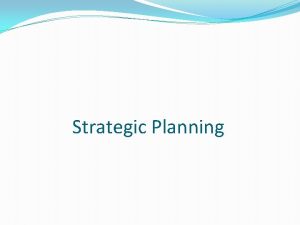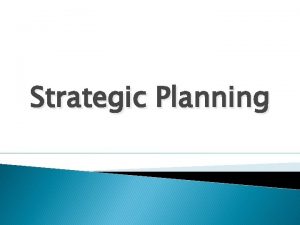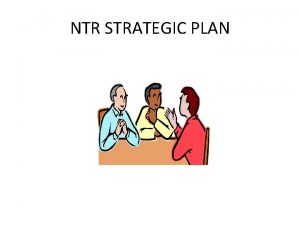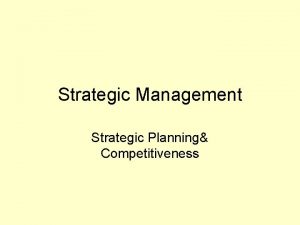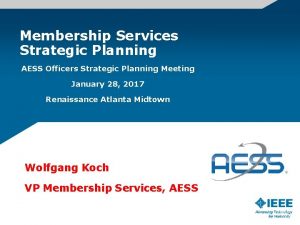IT Strategic Planning Models For Strategic Planning n




















- Slides: 20

IT Strategic Planning

Models For Strategic Planning n Boston Matrix n Mc. Farlane Matrix n Porter’s Five Forces n Porter’s Value Chain n Zuboff’’s 3 Eras n Networked Organisation n Strategic Alignment

Boston Consulting Group Product Portfolios High Wild Cat or Problem Child Star Market growth Cash use Funds Cash Cow Dog Low High Low Market share Cash generation

Product Characteristics n Stars - Best profit and growth potential - High market growth potential, high market share - High in cash generation but needing significant cash investment n Cash cows - Stars that become established and generate cash without the need for significant new investment - Minor changes may sustain the product in the market

Product Characteristics n Dogs - Product becoming obsolete in the market - New products erode market position - Further investment may not be justified or considered beneficial n Wild Cats - High cash requirement with little cash return - Cash flow from cash cows may support development - Need to quickly divest “problem children”

Product Life Cycle Net cash flow + Wild cat Star Cash cow Dog

Mac Farlane Matrix Application Portfolio High Turnaround Strategic Support Factory Strategic impact of planned application development Low High Strategic impact of existing applications

Mac Farlane Matrix Application Portfolio n Strategic - Current and future applications are critical for success n Turnaround - Current applications beneficial but not critical - Future applications may be of strategic importance n Factory - Applications that are critical to sustaining existing business - Development portfolio not vital to the organisation n Support - Current and future applications improve management and performance but are not critical to the business

Porter’s Five Competitive Forces Threats from new entrants Bargaining power of suppliers Rivalry among existing competitors Threats from substitutes Bargaining power of customers

Rivalry Among Existing Competitors n Industry growth n Fixed costs/added value n Intermittent overcapacity n Product differences n Brand identity n Switching costs n Concentration and balance n Informational complexity n Diversity of competitors n Corporate stakes n Exit barriers

Bargaining Power Of Suppliers n Cost relative to total purchases in the industry n Impact of inputs on cost of differentiation Supplier concentration n Importance of volume to suppliers Supplier goods make up a large part of firm’s costs n Supplier size v customer size n Differentiation of inputs n Switching costs of suppliers n Presence of substitute inputs n n

Bargaining Power Of Customers n Buyer concentration n Price sensitivity n Buyer volume n Price of total purchases n Buyer switching costs n Brand identity n Buyer information n Impact on quality n Substitute products n Impact on performance

Threats From New Entrants n Economies of scale n Proprietary products n Brand identity n Switching costs n Capital requirements n Number of existing rivals n Access to raw materials n Access to distribution channels n Absolute cost advantage n Government policy n Expected retaliation n Existing patents n Skills required

Threats From Substitutes n Relative price/performance of substitutes n Switching costs n Customer awareness of substitute products n Buyer propensity to substitute n Existing customer loyalty n Customer sensitivity to value for money and ability to compare

Porter’s Value Chain Model Support activities Firm infrastructure General management, accounting, finance, strategic planning Human resources management Recruiting, training, development Product/technology development R&D, product and process improvement Procurement Profit margin Primary activities Purchasing of raw materials, machines, suppliers, services Inbound Logistics Operations Outbound Logistics Marketing and sales Services (raw materials handling, warehousing) (maching, assembling, testing) (warehousing, distribution) (advertising, promotion, pricing, channel relations) (installation, repair, parts)

Zuboff’s 3 Eras n Automate - Basic transaction processing systems n Informate - Management information systems - Decision support systems n Transformate - Changing the structure of organisations and industries - Innovative uses of IT

Networked Organisations n Managing interdependence - Shared goals Shared expertise Shared work Shared decision making Shared timing and issue prioritisation Shared responsibility, accountability and trust Shared recognition and reward

Strategic Alignment Process Global Information Technology Platform Competition and Reconfiguration Process Competitive Potential Transformation Business Value Organisational Change Processes And Human Resource Issues Organisational Infrastructure And Processes Information Technology Strategy Business Strategy Strategic Alignment Process Technology potential Embedded Technology Information Systems Infrastructure And Processes Service Level IS Implementation Processes, Tools And Skills

Approach To Strategic Planning

Approach To Strategic Planning Internal analysis Marketing Finance Production Organisation External analysis Society Technology Industry Competitors Customers SWOT Analysis Strengths Opportunities Weaknesses Threats Strategy Formulation Business Idea Strategic Direction Main Goal Critical Success Factors Overall Plan General Plans for Functional Units
 What is the difference between models and semi modal
What is the difference between models and semi modal Strategic planning vs tactical planning
Strategic planning vs tactical planning Describe the phenomenon
Describe the phenomenon Shrm vs hrm
Shrm vs hrm Kontinuitetshantering i praktiken
Kontinuitetshantering i praktiken Typiska drag för en novell
Typiska drag för en novell Tack för att ni lyssnade bild
Tack för att ni lyssnade bild Vad står k.r.å.k.a.n för
Vad står k.r.å.k.a.n för Shingelfrisyren
Shingelfrisyren En lathund för arbete med kontinuitetshantering
En lathund för arbete med kontinuitetshantering Kassaregister ideell förening
Kassaregister ideell förening Personlig tidbok fylla i
Personlig tidbok fylla i Anatomi organ reproduksi
Anatomi organ reproduksi Densitet vatten
Densitet vatten Datorkunskap för nybörjare
Datorkunskap för nybörjare Tack för att ni lyssnade bild
Tack för att ni lyssnade bild Mall för debattartikel
Mall för debattartikel För och nackdelar med firo
För och nackdelar med firo Nyckelkompetenser för livslångt lärande
Nyckelkompetenser för livslångt lärande Påbyggnader för flakfordon
Påbyggnader för flakfordon Tryck formel
Tryck formel

























